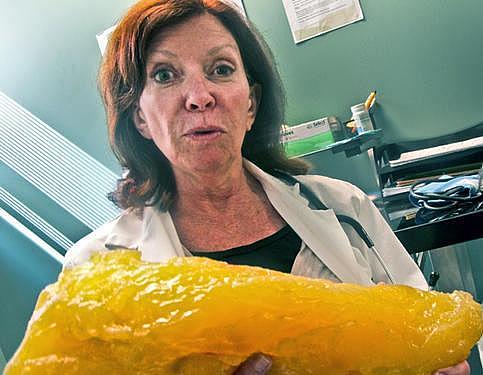Extra Fat Equals Extra Problems
This story is part of Kate Long's fellowship project where she explores West Virginia's epidemics of chronic disease and obesity and the efforts to reserve them. The series is called "The Shape We're In."


CHARLESTON, W.Va. -- "Start with this fact," Dr. Sally Swisher said. "If you eat more sugar than you burn with exercise, your body generates fat."
Swisher is a neurologist and bariatric doctor at Charleston's Medical Weight Loss and Skin Care Clinic.
The body turns food into glucose, she explained. It's straightforward, almost mathematical. Your muscle cells use most of the glucose for fuel. If you exercise a lot, your muscles burn up a lot of glucose. If you're a couch potato, your glucose doesn't burn up -- and the body converts it into fat.
Globs of sunny yellow fat -- unused glucose -- float through your arteries in your blood to the organ or tissues where they are deposited.
"Picture your arteries coming out of your heart like big rivers," Swisher said. "The farther they are from the heart, the smaller they get, and the easier it is for fat to clog them up. By the time arteries get to your feet and hands, they're tiny."
Fat cells float through these arteries. Along the way, they are deposited on tissue and organs. When fat finds a home in an organ, it can cause problems. If enough fat is deposited, it causes big problems.
That's an "extremely simplified version of the way it happens," Swisher said.
Inside the arteries, fat aggravates the walls as it floats along, then inflames them, Swisher said. "Fat cells slip underneath the inflamed lining. That constricts the artery. It used to be called hardening of the arteries."
If the inner artery wall becomes harder and rougher, the blood has a harder time getting through, and blood clots are more likely to form.
"There is bad fat and good fat," Swisher said. Exercise generates good fat, known as HDL cholesterol. It lowers all kinds of health risks. Bad fat -- called triglycerides and LDL cholesterol -- inflames artery walls. "It's not just innocent baby fat," Swisher said.
"When we are children, our bodies create the number of fat cells we will have for the rest of our lives, research shows," she said. "If people have too many fat cells when they reach adulthood, they are more likely to have trouble with weight for the rest of their lives."
Extra weight can raise a person's risk of many different kinds of problems:
Heart failure: "A hundred extra pounds makes your heart muscle thicken, just like any muscle working overtime," Swisher said. "A bigger heart eventually leads to heart failure."
A heart has to work extra hard to pump blood through a large body. The strain can cause a heart attack or stroke.
Fat can be especially dangerous inside arteries that supply the heart. It interferes with heart function and can set off heart attacks.
Sleep apnea, which is almost always caused by obesity, Swisher said. "Obese people often have fat in the back of their throats. When they lie down, the weight of their chest is on top of them. They don't have enough oxygen, so they wake up tired, or their spouse hears them struggling to breathe."
Diabetes: Belly fat has a lot to do with Type 2 diabetes, which used to be called "adult onset" diabetes. Thirty years ago, people under 20 almost never got it. Now it is showing up in obese teenagers and children.
Type 2 diabetes -- 90 to 95 percent of all diabetes -- can be prevented with exercise and healthy diet.
Parkersburg native Dr. Frank Schwartz, who directs the diabetes/endocrine program at Ohio University, explains the role fat plays in diabetes:
Glucose (digested sugar) can't enter the cells to provide fuel without insulin, a hormone secreted by the pancreas. Insulin interacts with the glucose and lets it enter the cells, like a key that opens the door to the cell. But fat secretes hormones that can keep the key from working.
When glucose can't enter the cells, that's called insulin resistance. The more fat, the more interference. The more interference, the more insulin resistance.
When glucose cannot enter the muscle cells, a person has diabetes. Digested sugar stays in the person's bloodstream and his or her blood sugar goes up. The body converts much of the sugar into fat.
Type 2 diabetes can start in the body 10 years before a person feels symptoms, research says. If a 30-year-old develops diabetes, it might have started at age 20. When a 15-year-old develops diabetes, it might have started at age 5.
Physical activity counteracts insulin resistance and increases the amount of glucose that can reach the cells. "That's a major reason why physical activity can prevent diabetes or help make it better," Swisher said.
Amputation: When little arteries get clogged with fat, circulation is cut off to the body parts farthest from the heart: including feet and hands. They don't heal well from infection and may get ulcers and gangrene. "That puts you at risk of amputation," Swisher said.
Kidney failure: "If small arteries leading to the kidneys get clogged, your body tries to overcome it, but after awhile, your kidneys just quit working," Swisher said. After that, a person needs expensive, time-consuming dialysis -- often four hours a day, three days a week, running the entire blood supply through a cleaning machine.
Stroke: Diabetics are more likely to have strokes, caused by constriction of small brain arteries. "That leads to clogging of the carotid arteries, which leads to strokes," Swisher said. Plaques of inflamed cells and fat build up inside the artery.
"People in their 30s and 40s with high cholesterol who smoke can have a premature stroke," she said. "If we don't get a grip on this, it's a matter of time till teenagers start having heart attacks and strokes."
Alzheimer's disease: In 2008, researchers found that obese people are twice as likely to get Alzheimer's as healthy-weight people are. Healthy-weight people with a "spare tire" are twice as likely to get dementia as healthy-weight people with no spare tire, they found. Nobody knows yet why that happens.
Liver disease: Fat deposited on the liver can lead to cirrhosis of the liver. Obesity causes more liver failure than alcoholism does, according to the Centers for Disease Control and Prevention.
Cancer: Estrogen is stored in fat, so excess fat creates higher estrogen levels in the blood. "Extra estrogen in the blood also puts you at risk of cancers of the breast and uterus," Swisher said. The lining of the uterus may also get thicker with excess weight, which can cause cancer.
"Colon cancer is also related to obesity, though nobody knows why," she said.
Sexual dysfunction: Diabetes causes impotence in men, and very obese young women often don't ovulate. "They're infertile and have high insulin levels," Swisher said. "If they lose weight, they can become fertile again. Doctors joke that pregnancy is a side effect of weight loss."
Incontinence: "If a woman has 50 or 60 extra pounds, and she rides a bike or just sneezes, the pressure of the belly against the bladder can force urine out," Swisher said. A woman can undergo surgery to lift the bladder -- or she can lose weight, making the surgery unnecessary.
Musculoskeletal problems and arthritis: "If weight-bearing joints carry too much weight: knees, feet and, to a lesser extent, hips, the amount of arthritis accelerates as you get older," Swisher said. "Overweight people don't get over it as easily. Rehab is harder."
Blindness: Diabetes also can cause blindness. Fat clogs the artery leading to the retina, and "that can cause stroke in the eye," Swisher said. Young overweight girls can also go blind with "false tumor" condition, she said, in which fat creates pressure inside the skull, causing severe headaches. The bulge in the optic nerve may resemble a brain tumor.
"None of these things has to happen," Swisher said. "That's the important thing to remember. It's possible to prevent them all with exercise and diet. It's within most people's reach.
"If I were queen of the world," she said, "the first thing I'd do is take control of school lunches and get kids outside playing every day again."
This article was originally published on The Charleston Gazette.
Image by T. Lindenbaum via Flickr
